Add MFA with SMS OTP
# Add MFA with SMS OTP
SMS OTP is a One-Time Password (OTP) sent to the user's registered mobile number on Asgardeo. The OTP is typically valid for a short period, preventing unauthorized users from accessing the OTP and thereby adding an extra layer of security to the authentication process.
Follow the instructions below to configure MFA using SMS OTP in Asgardeo.
# Prerequisites
To get started, you need to register an application with Asgardeo. You can register your own application or use one of the sample applications provided.
Info
- You can use SMS OTP for multi-factor authentication only if a previous authentication step is configured with
username and password,magic link, or any federated authenticator. - Asgardeo SMS OTP uses Asgardeo events to publish the OTP Notification data.
# Set up SMS OTP
To enable SMS OTP for the organization:
On the Asgardeo Console (opens new window), go to Connections and select SMS OTP.
Update the following parameters in the Settings tab:
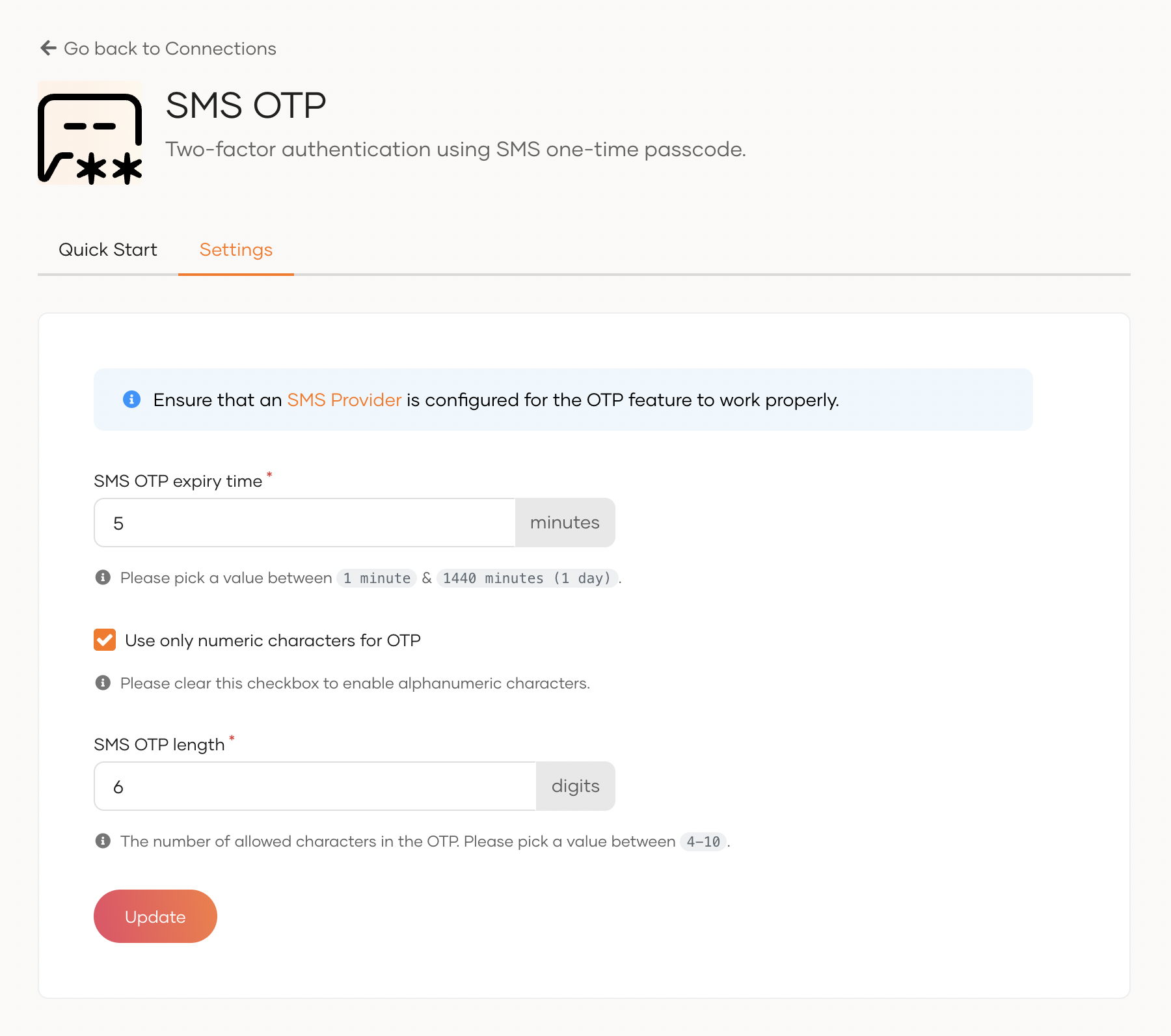
SMS OTP expiry time The generated OTP will not be valid after this expiry time. Use only numeric characters for OTP Specifies whether to use only numeric characters in the OTP. If this is selected, the generated OTP contains only digits (0-9). If this option is not selected, the OTP will contain alphanumeric characters. SMS OTP length Specifies the number of characters allowed in the OTP. Click update to save your configurations.
# Configuring SMS Providers
Configurations related to SMS providers are located under the Email & SMS section.
# Supported Providers
Asgardeo supports Twilio, Vonage, or custom SMS providers by default. To learn how to configure each provider, please see the relevant section.
Configuring Twilio
To configure Twilio as your SMS provider, follow the steps below:
- Go to Twilio (opens new window) and create an account.
- After signing up for your account, navigate to the Phone Numbers page in your console. You’ll see the phone number that has been selected for you. Note the phone number’s capabilities, such as "Voice", "SMS", and "MMS".
- After signing up, navigate to the Phone Numbers page in your console and note the phone number’s capabilities.
- Get your first Twilio phone number and use that as the “Sender” in the settings. For more information, see this tutorial in the Twilio documentation.
- Copy the Account SID and Auth Token from the Twilio console dashboard.
- Go to SMS Provider section in the Console and click the Twilio tab and fill the required fields.
| Name | Description | Example |
|---|---|---|
| Twilio Account SID | Account SID received in the previous step. | YourAccountSID |
| Twilio Auth Token | Auth token received in the previous step. | YourAuthToken |
| Sender | Phone number that you received when creating the Twilio account. | +1234567890 |
Configuring Vonage
To configure Vonage as your SMS provider, follow the steps below:
- Login to Vonage (opens new window) and create an account.
- Fill in the required fields and create the account.
- Login to the Vonage dashboard and copy the API Key and API Secret.
- Go to SMS Provider section in the Console and click the Vonage tab and fill the required fields.
| Name | Description | Example |
|---|---|---|
| Vonage API Key | Use the API Key from the previous step. | YourAPIKey |
| Vonage API Secret | Use the API Secret from the previous step. | YourAPISecret |
| Sender | The number that the receiver will see when you send an SMS. | +1234567890 |
Configuring a Custom Provider
If you are not using either Twilio or Vonage as the SMS provider, you can configure a custom SMS provider. Custom SMS provider configuration will pass the SMS data to the given URL as an HTTP request.
To configure a custom SMS provider, in the SMS Provider section click the Custom tab and fill the required fields.
| Name | Description | Example |
|---|---|---|
| SMS Provider URL | URL of the SMS gateway where the payload should be published. | https://api.example.com/api/v1 |
| Content Type | Content type of the payload. Possible values are JSON or FORM (Optional). | JSON |
| HTTP Method | HTTP method that should be used when publishing the payload to the provider URL. Possible values: PUT, POST (Optional). | POST |
| Payload Template | How the payload template should be. Placeholders: {{body}} - Generated body of the SMS. (Example - This can be the OTP). {{mobile}} - Number that this sms should be sent to. | Example JSON payload template: {“content”: {{body}},“to”: {{mobile}}}}( {{mobile}} and {{body}} will be replaced with the corresponding values at the runtime.) |
| Headers | Custom static headers need to be passed. If multiple headers need to be passed, they should be comma separated. (Optional) | authorisation: qwer1234asdfzxcv, x-csrf: true, x-abc: some-value |
# Add SMS OTP for an app
To add SMS OTP to the authentication flow of the app:
On the Asgardeo Console, go to Applications.
Select the application to which you wish to add SMS OTP.
Go to the Login FLow tab of the application and add the SMS OTP authenticator from your preferred editor:
Using the Classic Editor
If you don't have a customized login flow, you can click Add SMS OTP as a second factor.
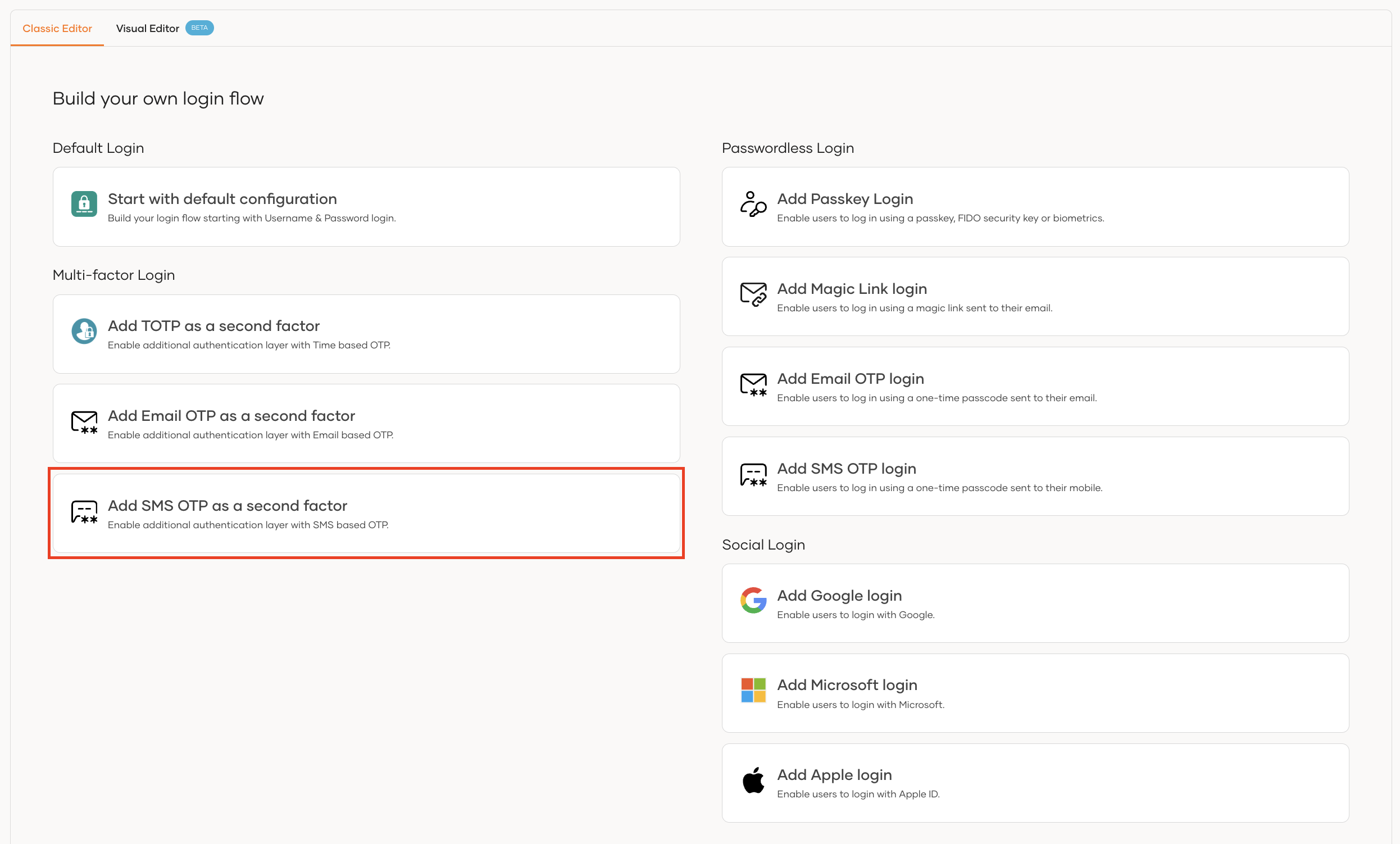
This opens the customized login flow with SMS OTP as a second-factor authenticator:
If you have an already customized login flow, you can add a second step and add SMS OTP as the authenticator.
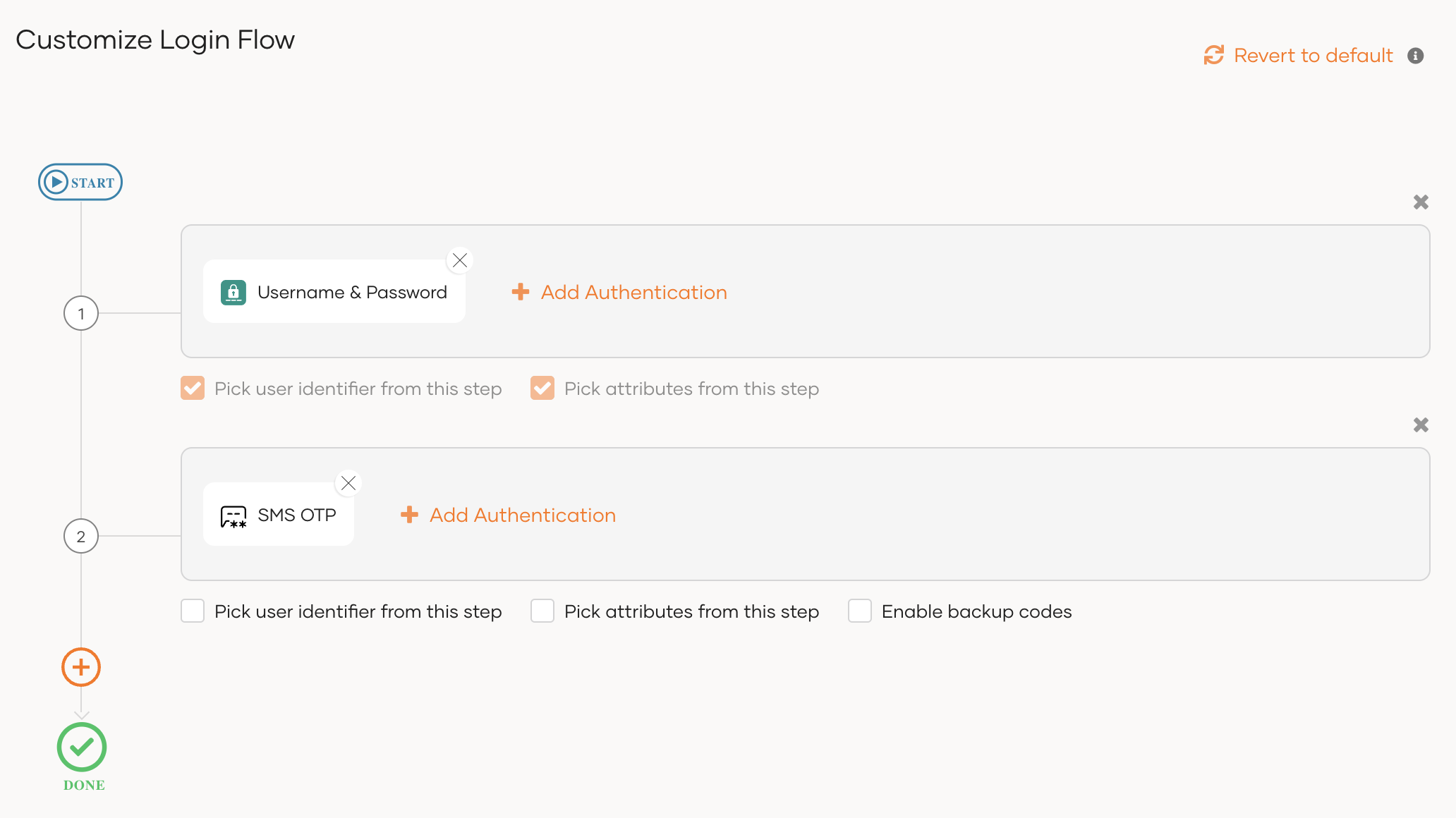
Using the Visual Editor
To add SMS OTP as a second-factor authenticator using the Visual Editor:
Switch to the Visual Editor tab and go to Predefined Flows > Basic Flows > Add Multi-factor login.
Select
Username + Password -> SMS OTP.Click Confirm to add SMS OTP as a second factor to the sign-in flow.
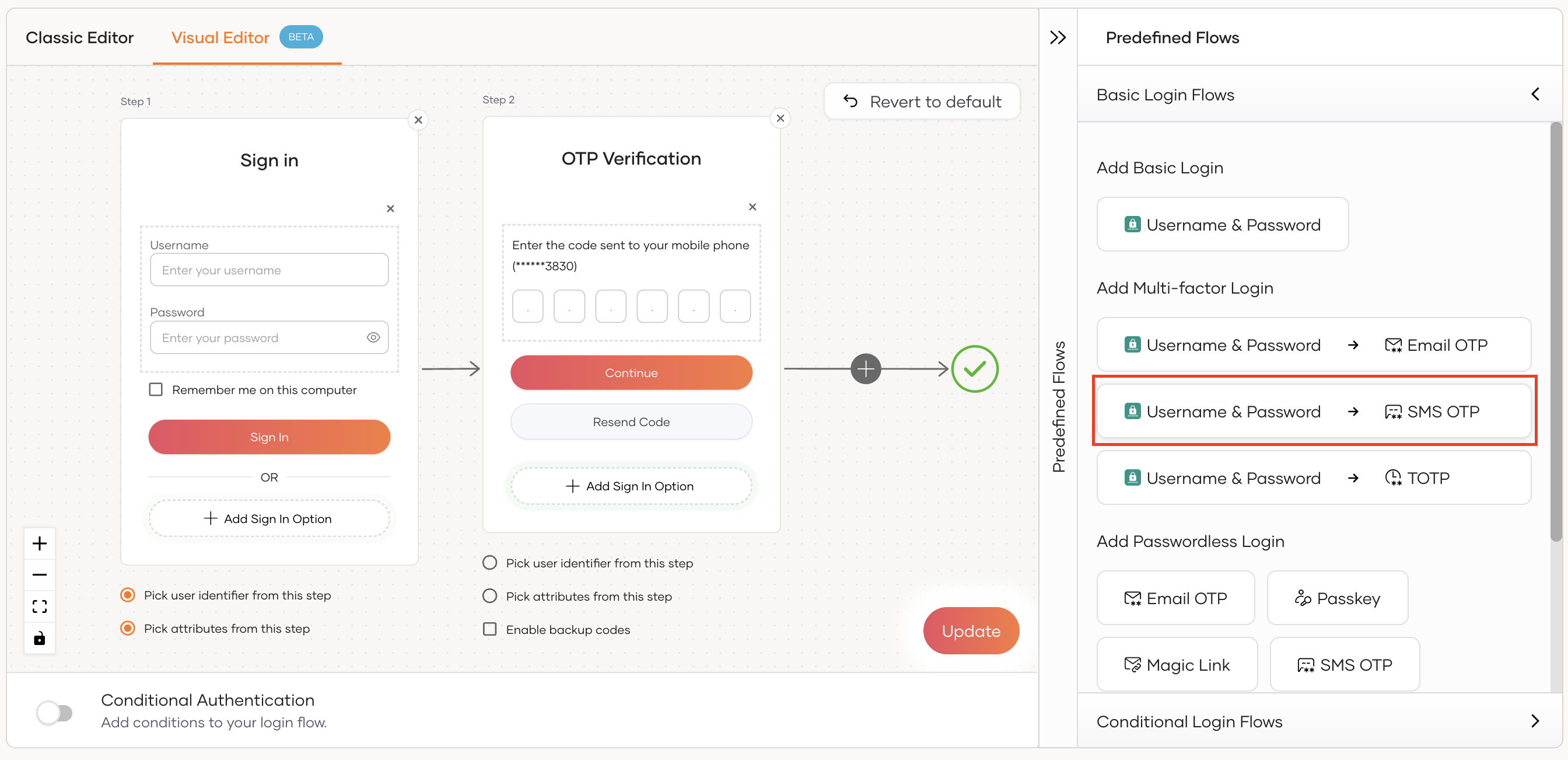
Enable backup codes
Once the SMS OTP authenticator is added, select Enable backup codes. This allows users to use their backup codes to log in to the application when they cannot obtain the required MFA codes.
Using the Classic Editor

Using the Visual Editor
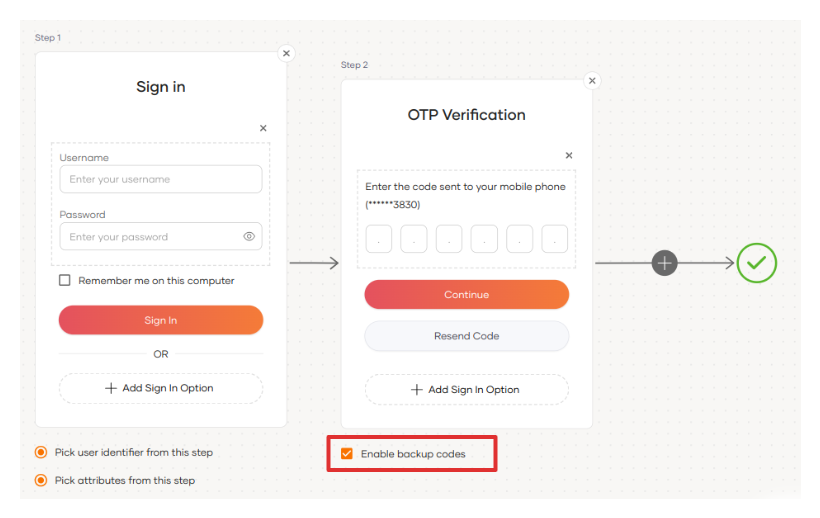
Learn more about configuring backup codes for business users.
Click Update to save your changes.
# Implement business logic for SMS OTP notification events
Asgardeo's SMS OTP authenticator publishes notification data events. You can create a webhook in Choreo (opens new window), WSO2's integration platform, to subscribe to these events and execute custom business logic, such as to send an SMS via an SMS gateway.
# Define the business logic
Follow the steps below to programmatically define the business logic to send an SMS OTP via an SMS gateway whenever a notification event occurs.
Prerequisites
You need to have a Github repository to host the business logic.
Download Ballerina (opens new window), the programming language used to define business logic for Asgardeo events.
Create a new Ballerina package. Learn how to do so in the Ballerina documentation (opens new window).
Navigate to the Ballerina.toml file and rename the organization name to that of your Asgardeo organization.
Navigate to your main.bal file and define the business logic.
New to Ballerina?
Learn more about the Asgardeo trigger module and how to program business logic for SMS OTP notification data events in the Ballerina documentation (opens new window).
The following sample logic logs the notification event in the Choreo console and sends an SMS Message via an SMS Gateway.
import ballerinax/trigger.asgardeo; import ballerina/http; import ballerina/log; import wso2/choreo.sendsms; configurable asgardeo:ListenerConfig config = ?; listener http:Listener httpListener = new(8090); listener asgardeo:Listener webhookListener = new(config,httpListener); sendsms:Client sendSmsClient = check new (); service asgardeo:NotificationService on webhookListener { remote function onSmsOtp(asgardeo:SmsOtpNotificationEvent event) returns error? { //logging the event. log:printInfo(event.toJsonString()); //read required data from the event. asgardeo:SmsOtpNotificationData? eventData = event.eventData; string toNumber = <string> check eventData.toJson().sendTo; string message = <string> check eventData.toJson().messageBody; string response = check sendSmsClient -> sendSms(toNumber, message); log:printInfo(response); } } service /ignore on httpListener {}1
2
3
4
5
6
7
8
9
10
11
12
13
14
15
16
17
18
19
20
21
22
23
24
25
26
27
28
29
30SmsOtpNotificationEvent Metadata
The payload of the
SmsOtpNotificationEventcontains the following metadata:Security Data object: The security data object is the same as all other Asgardeo events (opens new window). This contains the following security metadata about the event.
Property Name Type Description issString Issuer of the event iatString Event published timestamp. jtiString Unique identifier for the event. audString Audience of the event. Sample security data object:
{ "iss": "Asgardeo", "jti": "3b69b103-fa6c-424a-bbf4-a974d0c2d2a3", "iat": 1659732032884, "aud": "https://websubhub/topics/myorg/NOTIFICATIONS" }1
2
3
4
5
6Event Data object - The event data object contains the details of the event. This contains the following metadata about the notification event.
Property Name Type Description organizationIdint Organization Identifier organizationNameString Organization name sendToString Mobile number receiving the SMS OTP. messageBodyString Content of the SMS OTP Message Sample event data object:
{ "organizationId": 3, "organizationName": "myorg", "sendTo": "+1234567890" "messageBody": "Your one-time password for the myapp is 075052. This expires in 5 minutes.", }1
2
3
4
5
6
Commit your changes and push the code to your remote Github repository.
# Create a webhook in Choreo
Follow the steps below to create and deploy a webhook in Choreo.
Navigate to Choreo (opens new window) and if you don't have one already, create an organization with the same name and email address you used to create your Asgardeo organization.
Organizations in Asgardeo and Choreo synchronize based on their names.
Select a project from the Project dropdown.
Go to Components, and click Create.
Under the Select a Type tab, select Webhook. Learn more about webhooks in the Choreo documentation (opens new window).
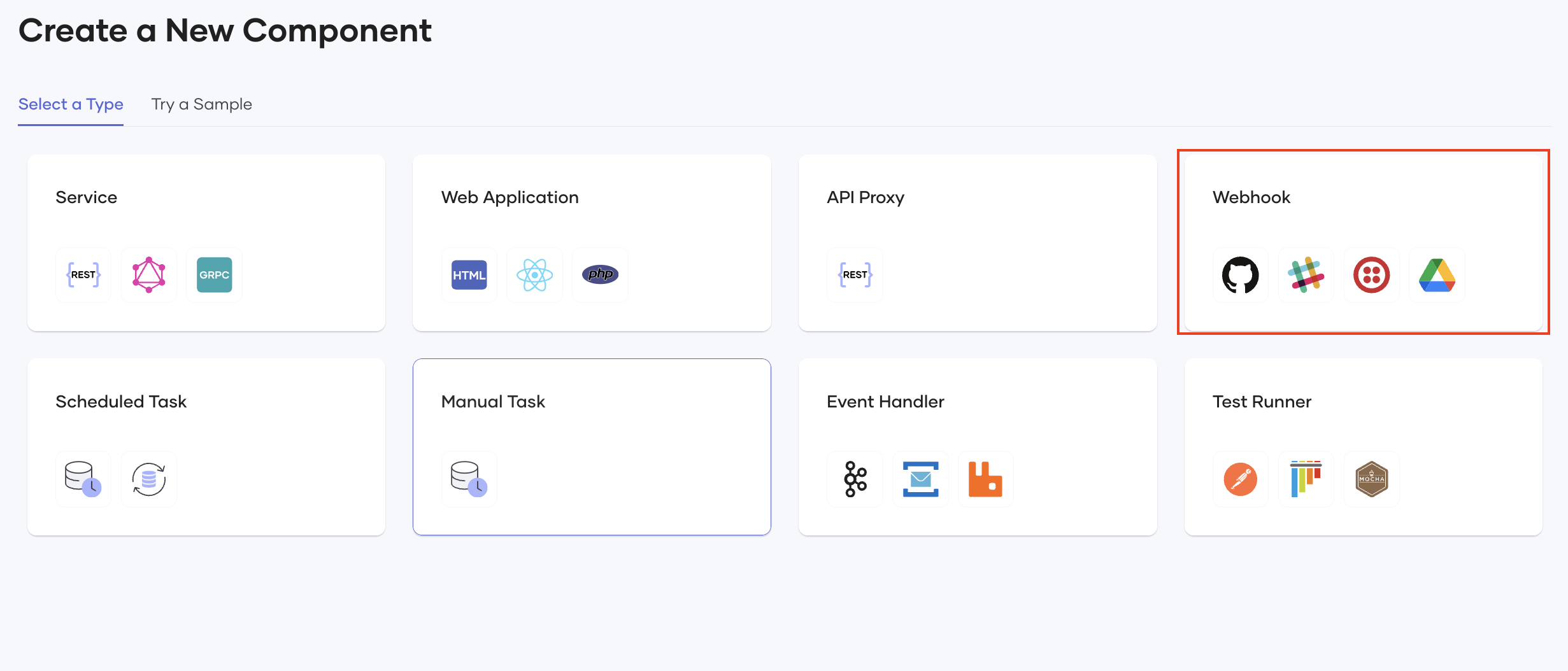
Enter a name and a description for your webhook.
Click Authorize with Github and connect the relevant organization, repository and the branch of the Github repository you created in the above section.
Select Ballerina to be the Buildpack and select the Ballerina Project Directory from your Github repository.
Select the Access Mode as External and click Create.
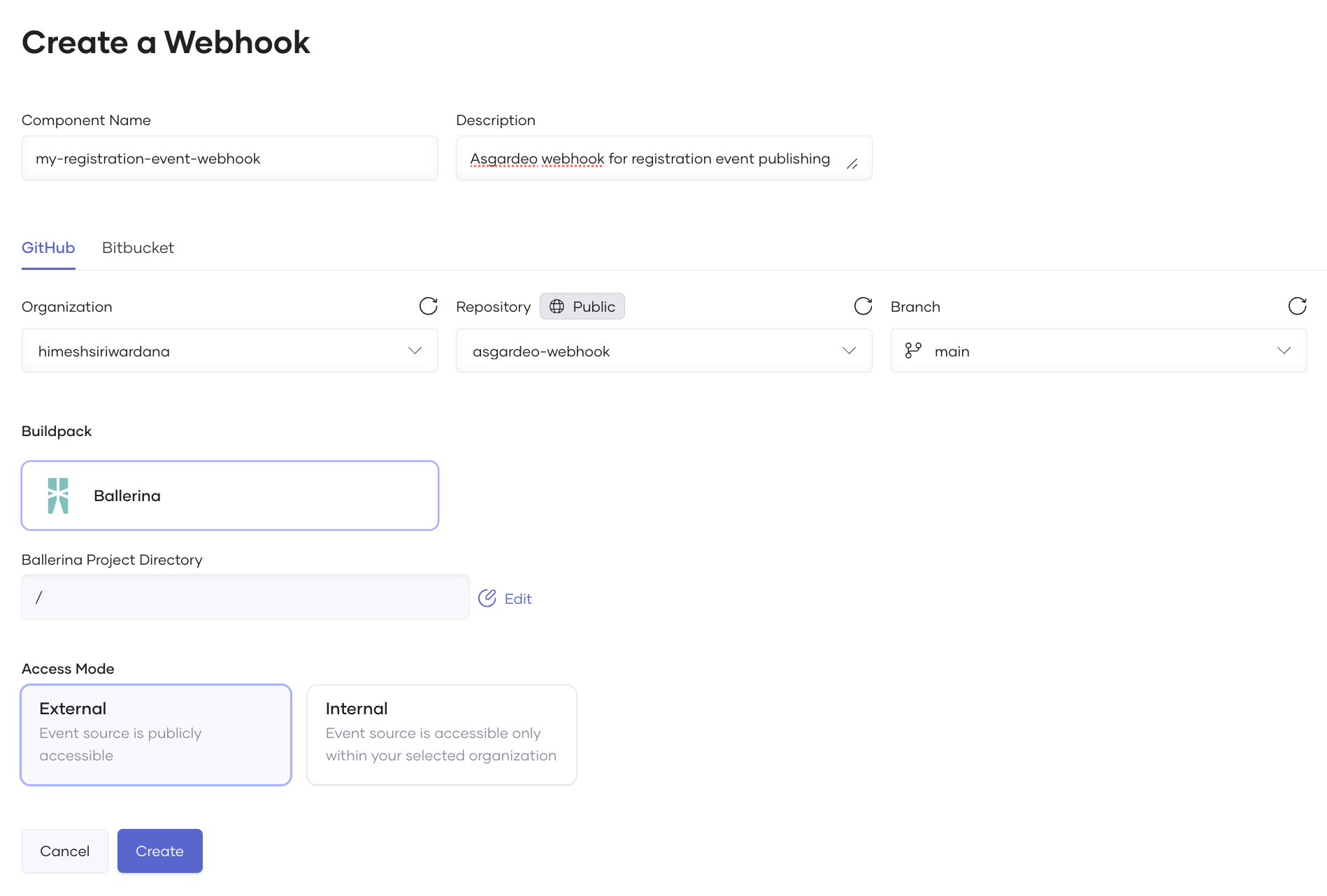
Follow the Choreo documentation and deploy your webhook (opens new window).
# How it works
When SMS OTP is enabled for the organization and added to the login flow of your application, the user is prompted to enter an SMS OTP after the preceding authentication steps are complete.
Given below are the steps involving SMS OTP.
Asgardeo sends the OTP to the user's registered mobile number.
Asgardeo prompts the user to enter the OTP code.
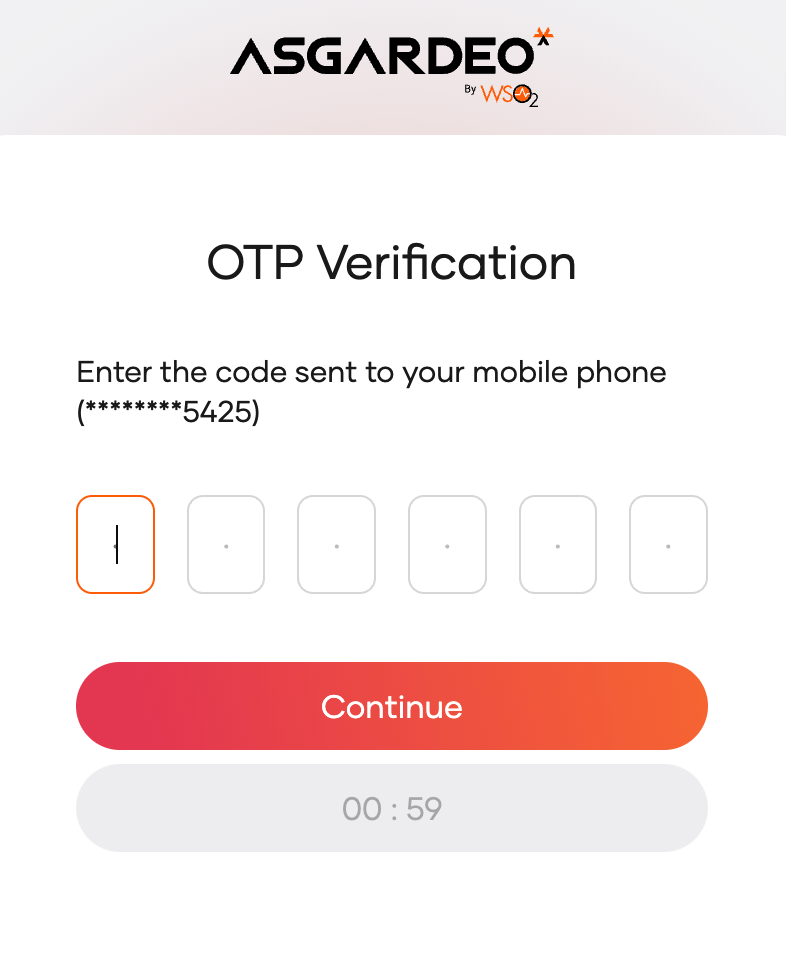
The user can request Asgardeo to resend a new OTP.
Asgardeo sends a new OTP only if the user has not exceeded the resend attempt count. The new OTP invalidates the previously sent OTP.
The user enters the OTP and clicks Continue.
On successful authentication, the user can access the application.
